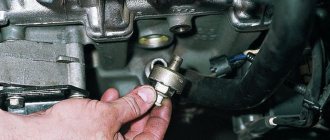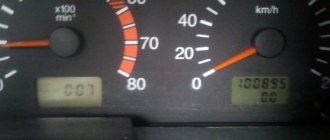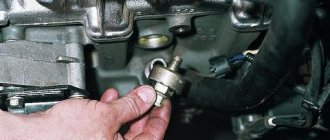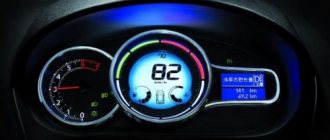Signs of a malfunctioning knock sensor. Check and replace at home. (Part 1)
Good day, friends.
I was often asked questions about this device, so in today’s article I would like to answer you the most frequently asked questions about this. After all, many car owners believe that a malfunction of the knock sensor does not interfere with the operation of the engine in any way, and in some ways they are right, but as always there is one BUT - over time, this malfunction will lead to the failure of other systems and mechanisms of this circuit. And this is much more waste on repairs than checking and, if necessary, replacing the knock sensor. But not everyone knows that in order to check and replace it is not necessary to go to a service center and ask for help from specialists, who most often have a level of knowledge in this area equal to yours and, in fact, will do a not so difficult job for which they will demand a tidy sum from you (I am now I don’t want to make anyone look stupid, it just happened to me personally in life). So, I just want to convey to people that all these procedures with a sensor are done very simply and do not require huge investments and waste of time. The main thing in this matter: 1) Perseverance; 2) Attentiveness; 3) Accuracy; 4) Well, hands from the place that God gave us)
Well, let's start with the basics.
What is a knock sensor? But here everything is simple - this is a part (part) of the control system that is responsible for controlling the level of detonation. Where can I find it? Everything is easy here too - we look on the engine cylinder block. Friends, just don’t get confused and don’t look for it on carburetor engines
. This sensor is installed on injection-type gasoline engines (where there is an electronic ignition system) and specifically on the engine body. The size of this part (if anyone hasn’t seen it) is literally proportional to the size of a matchbox.
It should also be noted that thanks to this device it becomes possible to save fuel
and the ability of the motor
to develop maximum power. The knock sensor regulates the vehicle's starting system and its operation.
In modern cars, as you know, you can see the operation of the sensor on the instrument panel and if there is a malfunction, the indicator will let you know about it.
(CHECK)
So, let’s now look at the operating principle of this device.
It consists of a piezoelectric mechanism (there is a plate inside that has a piezoelectric effect). So, when that same detonation occurs, voltage appears at the output and input. The result is engine vibration. A so-called potential difference is created, in which the voltage level at one end exceeds the level at the other. The sensor, in turn, “is engaged” in adjusting this process.
If for some reason the sensor fails, the “
Check ” indicator lights up on the instrument panel.
Conclusion - immediate repair or replacement of the sensor itself is necessary.
Verification methods
It is easy to check the inoperability of the DD yourself without dismantling it by conducting preliminary testing.
How to do it:
- put the engine at idle speed (about 2000 rpm);
- lightly tap with a hammer near the sensor.
A drop in engine speed (which will be audible) will indicate the serviceability of the part . If the speed remains unchanged, then the piezoelectric element is tested additionally. To do this, the DD will need to be removed by unscrewing the mounting bolt and disconnecting the block.
Then use a voltmeter or multimeter .
The procedure is as follows:
- connect the tester to the DD contacts;
- set constant voltage mode;
- Using light taps on the sensor, monitor the meter readings.
Symptoms of a knock sensor failure.
Hello. Today I wanted to talk about the knock sensor and the symptoms of its failure. Using the example of VAZ family cars.
The knock sensor is an important element of modern engine management systems. In carburetor systems, the ignition angle was changed by adjusting (turning) the distributor. In injection systems, the adjustment is controlled electronically.
On engines of the VAZ family, the knock sensor (DS) is installed on the cylinder block between the 2nd and 3rd cylinders.
The operation of the sensor is based on the piezoelectric effect. From mechanical impact, the sensor begins to generate voltage. The sensor is located in the place of greatest heating, from where the spread of detonation combustion begins. The sensor is configured to perceive noise with a frequency of 25-75 Hz.
As written above, from the influence of mechanical impulses, the knock sensor begins to generate voltage, which is supplied to the electronic engine control unit (ECU).
If the voltage exceeds the critical value, the electronic unit, after processing the signal, adjusts the ignition angle, making it late. The system then optimizes fuel injection. This allows you to achieve efficiency and maintain the intended engine power.
If the knock sensor fails, the engine malfunction lamp comes on. The following errors may occur: "Open knock sensor", "Low noise level". If there is increased noise during engine operation, the following error message may appear: “High noise level.” If the sensor fails, you can continue driving, the car will not stop. But the following symptoms and consequences should be noted:
- Loss of engine power;
- Deterioration of throttle response;
- Increased fuel consumption.
We check the condition of the connector and wires leading to the sensor. If everything is fine with them, we change the sensor.
It should be noted that a quality knock sensor is not easy to find. There were even dummies: there was no piezoelectric element inside the sensor. The contacts were just sticking out in the plastic. I buy knock sensors from the Autocom manufacturer.
Not an advertisement. You'll just save time. But even here there are already fakes.
Source
Can the device fail?
Like any other part, this device may stop sending a signal to the ECU.
This may indicate a temporary failure or complete failure of the device. This can happen due to:
- the presence of large corrosive formations;
- wiring violations (this indicates an open circuit);
- serious malfunctions that occurred due to the device being broken;
- incorrect replacement of the device itself.
But are there any signs of trouble? Undoubtedly. A breakdown may be indicated by uncharacteristic engine behavior, which manifests itself in:
- a clear drop in engine power;
- a sharp increase in speed at low speeds;
- significant deterioration in car acceleration performance;
- increased consumption of fuel fluid.
All these symptoms indicate that something is wrong with the device. But before you think about buying a new device, you should diagnose the old one. To do this, you need to know how to check the knock sensor, as well as where it is located. Let's focus on the last one for now.
What is a knock sensor and why is it needed?
This part is found in cars that use gasoline as fuel. It is intended for injection types of engines. The sensor is located on the engine cylinder block. This is an important part of the control system, the main purpose of which is to control the level of detonation.
In answering the question of what the knock sensor is responsible for , it should be noted that thanks to it the following vehicle capabilities are realized:
- Fuel economy.
- The ability of the engine to develop maximum power.
The sensor monitors the vehicle's starting system and regulates its proper operation.
What are the main components of a knock sensor?
The main details of this mechanism are:
- Vibrating plate.
- Piezo type electrical element.
- Signal wire.
- Braid.
How to check different types of knock sensors with a multimeter and other methods
Nowadays, scientists strive to provide people with maximum comfort. This applies to all areas of life, and cars are no exception. Thus, to facilitate the operation of this vehicle, sensors and control systems are introduced into the mechanisms, which are responsible for the vital functions of the vehicle. Their main task is to assess the state of certain non-electrical parameters.
This assessment is converted into an electrical signal, which tells us about problems. Such an electrical signal can be voltage, frequency and other factors, then this data is converted into an electrical code, which is output to the control unit. One of the most important mechanisms is the knock sensor. If it is faulty, checking the mechanism will not be difficult.
What is a knock sensor
This device is responsible for determining the moment of detonation in an internal combustion engine. The sensor is highly reliable, but requires regular maintenance. It constantly needs cleaning of the connector, which is not difficult. Based on its operating principle, it can be compared to a piezo lighter.
The more powerful the blow falls on him, the higher the tension. The sensor continuously monitors engine detonation knocks. When a sensor failure occurs, fuel consumption increases, and engine dullness also appears. While driving, you can hear a characteristic knocking sound, and the power of the car itself decreases.
The sensor is mounted between the third and second cylinders on the engine block, near the radiator. When detonation occurs, vibration occurs. It causes the piezoelectric plate to compress and a potential difference to appear at its ends.
Thanks to the electrical impulses of the sensor, the electronic control unit adjusts the ignition timing, bringing it to the most optimal, which leads to efficient and complete combustion of the fuel-air mixture in the engine cylinders. In addition, the sensor allows the engine to adapt to fuels having different octane numbers.
Types: resonant and broadband
All internal combustion sensors can be divided into:
- resonant (barrel);
- broadband (tablet).
Resonant sensors are tuned to the frequency of microsound, and therefore send a signal to the controller only when it is detected. As for the broadband type sensor, it constantly transmits the full spectrum of noise to the control unit. This helps the system obtain more information and independently detect noise corresponding to detonation.
How to understand that the sensor is broken
Such a sensor is usually installed in cars that have an electronic control circuit. In the event of a malfunction on the dashboard, the sensor simply begins to become active. A sign of a malfunction is the appearance of the Check engine message.
When the sensor malfunctions, the vehicle's acceleration is significantly impaired. The car continues to start, but operating efficiency drops significantly. Also, at rpms below 1000, vibration can be seen, and the amount of smoke from the exhaust increases.
Reasons for what is happening
All malfunctions can be associated with the car’s electronics. These include:
- signal wire break;
- occurrence of a short circuit to ground;
- short circuit of the on-board network of any wire of the device;
- damage to the shielding braid;
- failure of the control unit;
- damage inside the sensor itself.
Since the cause of the breakdown can be various options, you should check a number of system elements. First of all, you should inspect the sensor wires and understand what condition they are in, and also conduct a thorough check of the sensor plug and harness socket. If everything is fine with them, pay attention to the socket contacts. If damaged components are found, they should be replaced.
Where is the knock sensor located?
Depending on the make of the car, the location of the sensor may vary, but it is always located on the engine body. The part itself is very small, about the size of a matchbox.
Part installation features
An important feature of installing the sensor is the presence of an electronic ignition system in the car. If it is not there, then there is no sensor. Older models do not have a knock sensor. It is also not installed on carburetor engine systems.
Replacing the sensor on a VAZ, video:
How to clean the sensor
There is a wide range of information on sensor cleaning available online. On some forums, members suggest cleaning it with a special liquid such as contact cleaner. However, this mechanism is quite fragile and can be damaged if handled incorrectly. It is best to replace the mechanism with a new one.
On the other hand, the detonation mechanism has a specific tightening torque. If the torque changes, the generated signal may be affected. Therefore, it is necessary to know what a tightening contact is so as not to damage the mechanism during installation.
Sensor operation
There is a "Check" icon on the car's dashboard. In English this translates as check or control. If it is not active, then the knock sensor is working and working as expected.
If it is active, a comprehensive diagnosis should be carried out, since the cause is not always the knock sensor. You can do your own diagnostics using an ODBII scanner.
A special feature of this auto scanner is the diagnostics of not only the engine, but also other components of the car (gearbox, abs, transmission, etc.). The scanner is quite easy to use and has Russian-language software, which will help with identifying the malfunction. The following errors will indicate a problem with the knock sensor: P0325, P0326, P0327, P0328.
The next step would be to erase the errors using Scan Tool Pro and check whether the “Check” lights up again, in which case inspect the wiring and contacts on the sensor in detail, eliminating the possibility of breakage or oxidation.
Then you should begin checking the sensor itself using a multimeter in the manner described in the next chapter.
The operating principle of the knock sensor is based on a piezoelectric mechanism. Inside the sensor there is a plate with a piezo effect. When detonation occurs, voltage is created at the input and output, and the engine vibrates. Otherwise, this is called the creation of a potential difference. If the voltage level at one end is too high, the sensor corrects this process.
If for any reason the sensor breaks down, the “Check” icon will light up on the dashboard. This will mean only one thing: urgent repair or replacement of the element is required.
If the electrical circuit of the sensor is not broken, but a breakdown exists, the “Check” icon will not light up. Therefore, it is worth listening to your car sometimes.
List of errors associated with DD from the on-board computer
The cause of the failure can be found out by analyzing the error signal on the console:
- 0325 indicates a break in the DD circuit, which can be eliminated by cleaning the sensor connectors from oxidation and ringing the wiring;
- 0325 may also indicate that the timing belt is shifted by one tooth; it is necessary to check that the belt is installed correctly;
- 0326, 0327 indicates a low controller signal, requires checking the connectors, securing the nut with a force of 10-23 Nm, the action is performed with a special torque wrench.
- 0328 - the control signal is higher than normal, may appear when the electrical circuit is broken, a piercing element, or a faulty DD.
Symptoms of sensor malfunction
You can determine whether the sensor is broken without a dashboard. But this will require experience and a special approach to your car. You need to know him very well. We list the signs by which you can understand that the device is broken, from here it will be immediately clear what the knock sensor affects:
If you determine the breakdown yourself, then it’s not far to independently diagnose the sensor, as well as replace it yourself. In principle, this is not difficult, but it requires some understanding of the process.
What to do in case of malfunctions
Due to the fact that the on-board wiring on the car suffers from low reliability. The DD check must be performed in stages. In the event of a malfunction, you should walk along the entire line, including the sensor, and visually assess its condition. If individual sections of the chain have apparently lost their integrity, they are replaced.
If replacing the wiring does not help, you need to dismantle and check the sensor.
Removing the sensor
Dismantling the device is quite simple. This does not require special tools or deep knowledge of mechanics. The part has one contact group and is attached to the engine block using a bolt with a No. 10 head. To remove it, you need to disconnect the wires and unscrew the fixing screw.
DIY replacement
To install another DD with and without air conditioning, an identical procedure should be followed.
- Place the machine on a level surface.
- Remove the terminals from the battery.
- Allowing the machine to cool down will make the work more comfortable.
- Disconnect the power terminal from the sensor. If the group is worn out or heavily oxidized, it is better to change it along with the sensor.
- Unscrew the fastening bolt and use a screwdriver to remove the damaged part.
- Place a new DD in the seat and reassemble the chain in the reverse order.
There is also a video in Russian on how to change a problematic sensor.
Replacing the knock sensor
If it requires replacement, then it is necessary to purchase a new device and install it as soon as possible. All car enthusiasts are primarily interested in the price of a new device. It is low and depends on the make of the car and on the country in which the part was manufactured.
You can carry out the replacement yourself when the engine has cooled down by disconnecting the negative terminal of the battery. It is necessary to achieve the most convenient access to the sensor so that it can be removed. The fact is that it also depends on the car model.
Thus, the knock sensor is a simple device, yet very useful for an electronic control system. It is not difficult to determine its malfunction; you can check it yourself, even in rural areas.
It will also be inexpensive to replace the sensor. It doesn’t matter whether this is done by a specialist or independently.
Source
Device diagnostics
To be sure that the 2110/2112 knock sensor is faulty, it is worth checking it. This is done with a multimeter.
After all, you should understand that not in all cases the knock sensor will need to be replaced. In some cases, cleaning it will help. Sometimes other faults are detected that do not relate to the device itself. For example, an open circuit (network break). But in this case, the working connection diagram is subject to diagnosis.
If you don’t know how to check the device, then just follow the steps presented:
- Turn on the multimeter.
- Connect the wires to the two contacts of the broadband sensor. But there is a small note here: if we are talking about the resonant type, then the negative wire must be closed on the body, but the positive wire is in the center of the sensor.
- Take a screwdriver or any other metal object and start making small impacts on the sensor. But we’ll look at what this affects a little lower.
The thing is that, based on the force of the blows applied, the values on the measuring device will gradually change. They should fluctuate between 40–200 mV. This is the norm, which corresponds to the fact that the device is in good condition. But any serious damage to it will be reflected on the multimeter screen as a zero value.
Note that checking the knock sensor does not end there. Now you will need to identify the cause of the problem. Moreover, you need to look for it in the wires. In some cases, you may only need to replace the pad. The thing is that it is the one that is most exposed to the environment, which leads to corrosion on the contacts.
If you are interested in the question of how to diagnose an 8-valve injector, then you should note that in this case the process is more labor-intensive. The thing is that sometimes you need to spend extra time to remove it.
You will need:
- Dismantle the device.
- Set the multimeter to measure the applied voltage at about 200 mV.
- Place one probe on the connector of the device, and the second on the opposite connector.
- Start tapping with a screwdriver, as you did in the previous case. But focus your attention on the force of the blow, since the stronger it is, the higher the signal level should be.
- Finally, check the resistance of the piezoelectric element.
In general, the VAZ 2110 8-valve injector sensor breaks down extremely rarely. The most common reason for the absence of a signal on the ECU is a break in the connection circuit.
If this device is seriously damaged, you should consider purchasing a new one. But you definitely need to familiarize yourself with how to replace the knock sensor, because installing it incorrectly can lead to the problem not being resolved.











